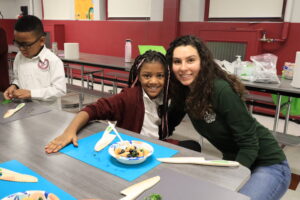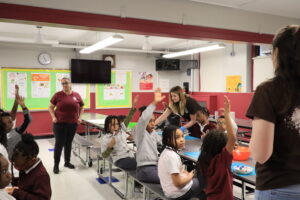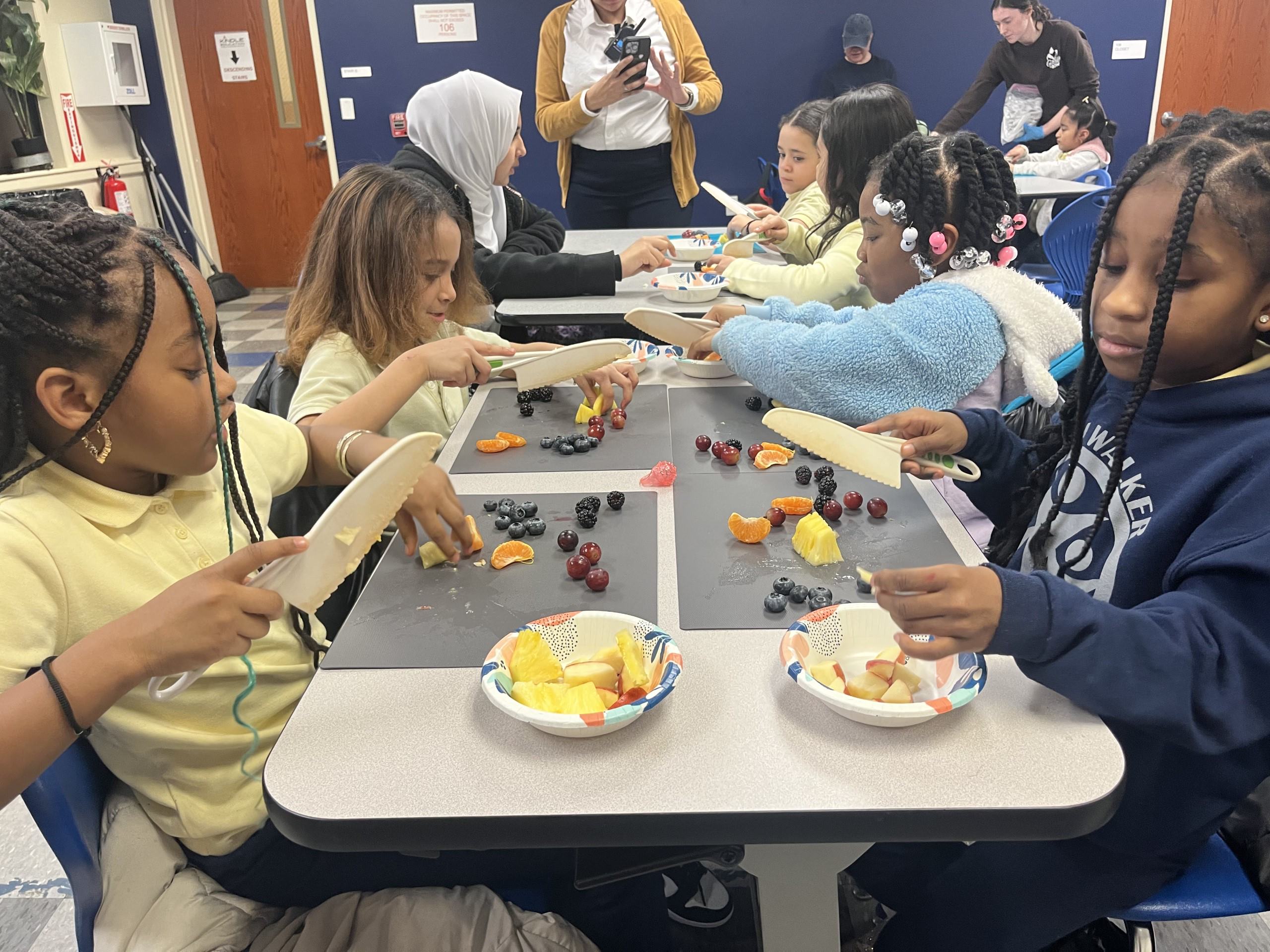By Programming Associates, Jess Huber and Kristen Senuto
For the educators at America’s Grow-a-Row, there’s no better feeling than watching a student’s face light up with delight and pride at the sight of a tasty snack that they made themselves. In just about an hour’s time, we watch a student’s journey from hesitance to exploration. By the end of our culinary lesson, they are skillfully gliding their knife through a piece of fruit or bravely trying new tastes and textures. This is our goal as we travel throughout New Jersey, visiting underserved schools in places like Newark and Jersey City to amplify students’ confidence and encourage healthy choices in the kitchen.
For most culinary lessons, we arrive at a classroom filled with mixed emotions. As we unpack our cooler, some students look apprehensively at the table of unfamiliar ingredients, while others squeal with excitement as we reveal fruits and vegetables that they recognize from their own kitchens. We begin the lesson with an important set of rules: The first rule is “Tools, not toys.” We emphasize to the students that the kid-friendly knives and other utensils that we provide must be used with care and responsibility. Our next two rules are “Don’t yuck my yum” and “You don’t have to try anything you don’t want to.” While we give students the choice to decide what ingredients they’d like to try, we discourage them from audibly dismissing any foods with words like “ew” or “gross.” We explain that their least favorite food may be someone else’s favorite. As one of our students said, negative comments can “hurt their heart.” We encourage students to think about what they dislike: is it the taste, texture, smell, or color? With this rule, we are instilling a sense of respect for all preferences and cultures. In fact, we choose to celebrate different cultures in the classrooms that we visit.
For each lesson, we bring our world map titled “Grow Around the World”. We discuss the geographical origin of ingredients that we use in the lesson and highlight seasonality and culture. We discuss how we can bring tropical fruits in the winter, like pineapple, because it is in season in another part of the world. For one of our partners in Jersey City, Team Walker, we taught four different lessons, traveling across oceans and countries on our map to introduce new recipes in each lesson. We made fancy fruit salads, summer rolls, pita pockets with veggies, and black bean and sweet potato tacos. We explored areas like Vietnam, the Middle East, and South America, celebrating the vastly different flavors found around the world. Along with learning about geography, students learn useful culinary skills. We teach them important techniques, like “bear claw”, which shows them how to properly hold their knives while cutting. We discuss the French phrase “Mise en place,” emphasizing the importance for chefs to prepare all their ingredients before constructing their dish. Students beam with pride as they set their station and carefully compose their own version of each recipe. They look in awe as seedy blackberries turn the knife purple and blissfully smell their fresh basil and other herbs for the first time. By allowing the students to approach each lesson with their own unique flair, a deep sense of ownership and pride is cultivated.




The autonomous aspect of our education program is vital to the impact that we make. We aim to provide a safe space for students to make informed choices and discover a wide array of culinary experiences. By infusing their own creativity into a dish and experiencing it with all five senses, they become more likely to try and enjoy new foods. During one lesson at Ann Street School in Newark, a second-grade student called us over and exclaimed that she would open her own restaurant and put fancy fruit salad on the menu, calling it “The Special.” This sense of pride and excitement extends beyond the classroom, influencing life at home. We heard from a teacher at Dr. William H. Horton Elementary School that “the students learned important skills to apply at home to increase nutritional snacks and meals.” Students can utilize new recipes and culinary skills at home, fostering a deeper connection to the food that they eat and positively influencing their future choices.
Between February and August of 2024, we have had the privilege of teaching 31 culinary lessons and over 1,500 underserved youth. It’s been memorable to observe the curiosity and empowerment that emerges from the incredible students that we teach. We look forward to continuing teaching youth about healthy eating and creating a lasting impact on each student that we serve. America’s Grow-a-Row deeply appreciates the opportunity to guide students through a culinary journey that instills in them an undeniable sense of pride and joy.

